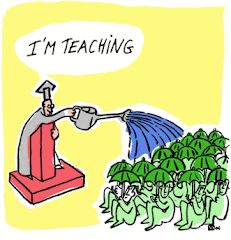Dear colleagues, while reading the descriptions of different types of syllabuses think about the principles behind each type of syllabus.
1. Grammatical
A list of grammatical structures, such as the present tense, comparison of adjectives, relative clauses, usually divided into sections graded according to difficulty and/or importance.
2. Lexical
A list of lexical items (girl, boy, go away . . .) with associated collocations and idioms, usually divided into graded sections. One such syllabus, based on a corpus (a computerized collection of samples of authentic language) is described in Willis, 1990.
3. Grammatical-lexical
A very common kind of syllabus: both structures and lexis are specified: either together, in sections that correspond to the units of a course, or in two separate lists.
4. Situational
These syllabuses take the real-life contexts of language uses as their basis: sections would be headed by names of situations or locations such as 'Eating a meal' or 'In the street'.
5. Topic-based
This is rather like the situational syllabus, except that the headings are broadly topic-based, including things like 'Food' or 'The family'; these usually indicate! fairly clear set of vocabulary items, which may be specified.
6. Notional
'Notions' are concepts that language can express. General notions may include 'number', for example, or 'time', 'place', 'colour'; specific notions look more like vocabulary items: 'man', 'woman', 'afternoon'. For an introduction to the topic of notional syllabuses see Wilkins, 1976.
7. Functional-notional
Functions are things you can do with language, as distinct from notions you can express: examples are 'identifying', 'denying', 'promising'. Purely functional syllabuses are rare: usually both functions and notions are combined, as for example in Van Ek, 1990.
8. Mixed or 'multi-strand'
Increasingly, modern syllabuses are combining different aspects in order to be maximally comprehensive and helpful to teachers and learners; in these you may find specification of topics, tasks, functions and notions, as well as grammar and vocabulary.
9. Procedural
These syllabuses specify the learning tasks to be done rather than the language itself or even its meanings. Examples of tasks might be: map reading, doing scientific experiments, story-writing. The most well-known procedural syllabus is that associated with the Bangalore Project (Prabhu, 1987).
10. Process
This is the only syllabus which is not pre-set. The content of the course is negotiated with the learners at the beginning of the course and during it, and actually listed only retrospectively (Candlin, 1984; Clarke, 1991).
Points for reflection
Analyse your own teaching situation and decide on type of syllabus you use with your students. Write a comment to describe it and see if there are any similarities with your colleagues.
Source: Ur, P. (2002) A Course in Language Teaching. Cambridge: CUP, pp.178-9







